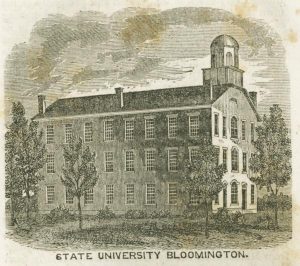By: Scott Jauch, Bicentennial Intern, Class of 2016, International Studies, Bloomington
My work for the Indiana University Bicentennial Internship Program centered on the history of IU’s buildings.
The first interesting piece of information that I discovered is that IU has not always been on its current campus, which is marked symbolically by the Sample Gates at the intersection of Indiana Avenue and Kirkwood Avenue. The original campus’ location is the square that contains (as of 2017) Kroger, Wendy’s, and Chase Bank.
The square is sandwiched between South College Avenue and South Morton Street facing north and south and West 1st Street and West 2nd Street facing east and west. Founded by the Indiana General Assembly as the State Seminary of Indiana, its original campus was known as Seminary Square.
Construction on Seminary buildings began on April 17, 1822.

Word quickly got out to the earliest of Hoosiers about the Seminary.
The Madison Indiana Republican in Madison, IN wrote an advertisement for the new state seminary; its buildings were in “a state of preparation” and “are erected on an elevated situation affording a handsome view of Bloomington, the county seat of Monroe County, and also a commanding prospect of the adjacent country, which is altogether pleasant and well calculated for rural retreats.”
The first building to be constructed was the Professor’s House, which would house the Seminary’s first instructor, Baynard Rush Hall. It cost $891 dollars to build, and was a “smaller structure enlarged somewhat by addition of a lean-to type of shed,” according to Thomas D. Clark in Indiana University: Midwestern Pioneer. The second completed building was the Seminary Building in 1825.
It was “a two-story oblong brick structure with evenly spaced windows and the projecting mid-roof bell tower so characteristic of contemporary academic and public buildings. Clark states that it “was originally intended to be a replica of Nassau Hall at Princeton.” It cost $2,400 to build.

The next major building associated with the Seminary that was completed was President Andrew Wylie’s house, which still stands today as a museum, located at 317 East 2nd Street, in 1835. According to Clark, it was “based on a solid limestone foundation, had a large basement, two main stories, and a fairly large attic.” It was also likely a way to please Wylie’s wife, Margaret, who never truly acclimated to life in Bloomington following their move from Pennsylvania.
Then Indiana General Assembly elevated the Seminary to the rank of a college in 1828 and changed its name to Indiana College. Indianan College dedicated the First College Building in 1836. It stood for 18 years until a fire destroyed it in 1854.
In 1838, the First Dormitory Building was constructed and attached to the Professor’s House! Imagine how that must have been. This was the first dorm officially under University control; before this, students acquired housing from private homes, often living with a host family. The next addition to the Seminary Square campus was the First Laboratory Building, completed in 1840.
The First College Building burned down on April 8, 9, or 11, 1854, and the fire’s cause is unknown. One theory is that cigar-smoking students tossed their lit trash into the janitor’s trash pile. Another theory that caught traction with the people in Bloomington was that some thieves lit the building on fire in order to draw attention away from the stores they intended to rob. Newspaper accounts report no such earlier lending more credibility to the first theory.

On October 11, 1919, the Indiana Daily Student reported that “[I]n 1854 the new building, with entire contents in the form of libraries and collections, was destroyed by fire. The friends of the University came to its assistance and another and better building was erected.
The structure, one of the most picturesque in Bloomington, was known as the Old College; it was purchased by the Board of Education of the City of Bloomington in 1897…In 1874 a second large building of design similar to that of the Old College was erected for the libraries and museum; but in a second fire, in 1883, this building was destroyed with all its contents.”
The Bloomington World reported on November 30, 1893, that the College Building burned on April 8, 1854, contradicting accounts that claim an April 9 or April 11 date.
One year after a fire destroyed the First College Building, Indiana University (elevated to university status in 1838) constructed another building to replace it. Because this new building was the first built following Indiana College’s change to Indiana University, it was called the First University Building.

To support its growing student body and to facilitate scientific research, IU constructed Science Hall in 1873. Unfortunately, Science Hall burned down on July 12, 1883.
This catastrophic fire, with destroyed many records and important scientific collections, prompted Indiana University to purchase new land to the east of Seminary Square.
Purchased from the Dunn family, IU moved its campus to Dunn’s Woods and first held classes in Owen Hall and Wylie Hall in 1885.
This transition marked the beginning of IU’s history on its current Bloomington Campus.